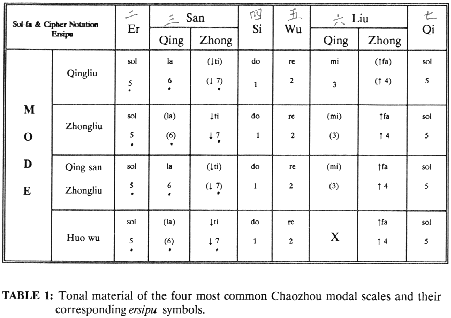
Chaozhou recognizes five modes.
Of these, the first two are considered the basic modes from which the others are derived. The names of the first four modes come from terms describing the action performed on the strings of a string instrument (ideally the zheng board zither), designated in ersipu notation as san and liu. The table below shows the tonal material of the first four modes.

Qing means lightly vibrating the string without raising the pitch, while zhong means heavily pressing the string so as to raise the pitch three-quarters of a whole tone. Thus, in the scale in the qingsan qingliu mode, the performer presses the strings corresponding to san (la) and liu (mi) only very lightly, only enough to create a slight vibrato to ornament these tones. In qingsan qingliu mode's inverse, zhongsan zhongliu , the performer executes zhong on the same strings, giving the tones lowered 7 and raised 4, respectively. In this mode, these two tones function as structural tones while la and mi function as ornamental tones, appearing only occasionally.
The reverse is true in the qingsan qingliu mode where la and mi are the structural tones, while lowered 7 and raised 4 act as ornamental tones.
The term huo, normally used in connection with the string corresponding to wu (re), means heavily pressing the string amd rapidly vibrating it up and down. The result is a wavering vibrato of the pitch of that particular string, hence the name huowu of the modal scale featuring this ornamented tone. The huowu modal scale is basically the same as the zhongsan zhongliu modal scale except for the absence of the tone liu (mi)
The fanxian mode is the result of performing a piece originally in the qingsan qingliu mode a fourth up or a fifth down the scale. The process, however, is not the same as transposing a piece into a different tonality as in Western music, since there is no conceptual shift in fundamental tone. F, the pitch traditionally established for do (1=F), remains designated as the fundamental tone. In addition, as the tuning of the scale itself is not equal in temperament, the intervallic relationship of the notes differs from those in a scale transposed a fourth up and thus whose fundamental tone has shifted to B-flat.